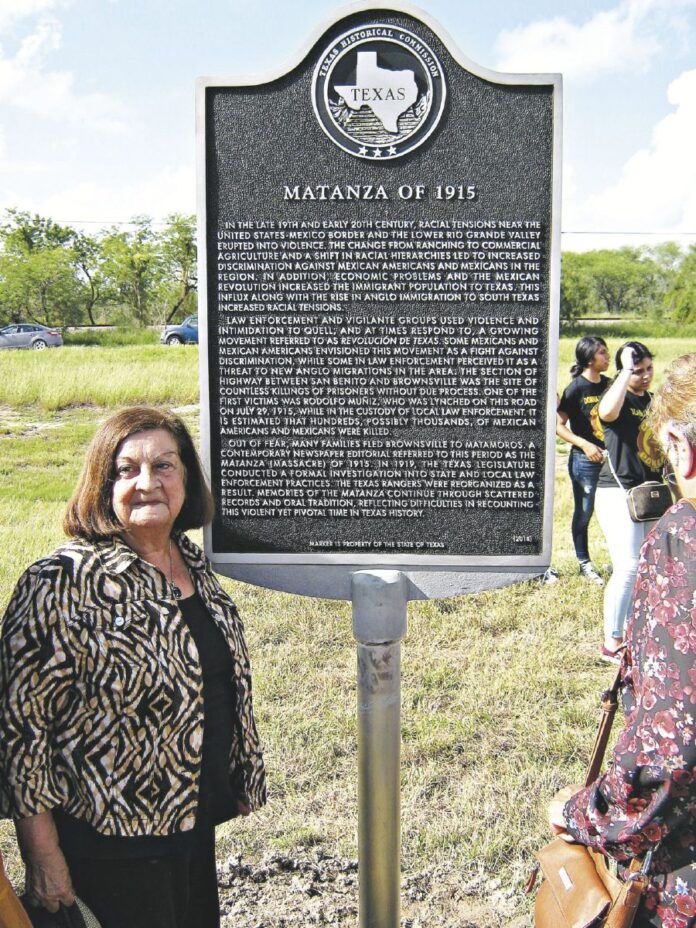BY NORMAN ROZEFF
On October 14, 2017, a somber but celebratory gathering took place along Expressway 77/83 south of San Benito. The attendees were there to recognize the unveiling of a Texas Historical Commission marker.
It had been awarded without cost to Cameron County as part of the THC’s Undertold Stories award, given annually to a limited number of Texas counties “to address historical gaps, promote diversity of topics, and proactively document significant underrepresented subjects or untold stories.”
The subject of the marker was The Matanza of 1915. Matanza is Spanish for massacre.
A knowledgeable committee formed in 2016 to create the Refusing to Forget Project. It consisted of Dr. Trinidad Gonzales, Professor of History, South Texas College, Dr. John Morán Gonzalez, Professor of English and Director of the Center for Mexican American Studies, the University of Texas at Austin; Dr. Sonia Hernández, Associate Professor of History and Director of Latina/o & Mexican American Studies, Texas A&M University; Dr. Benjamin Johnson, Associate Professor of History, Loyola University, Chicago; and Dr. Monica Muńoz, Stanley J. Bernstein ‘65 P’02 Assistant Professor of American Studies & Ethnic Studies, Brown University.
This committee compiled the narrative submitted to the Texas Historical Commission. They were assisted in their pursuit by Norman Rozeff, Marker Chairman, Cameron County Historical Commission.
The primary purpose of the Refusing to Forget Project was to recognize the violence done to Mexican American people in the Lower Rio Grande Valley over a century ago.
These sad events largely perpetrated by uncontrolled Texas Rangers (called locally “los rinches”) and others have been mostly forgotten today.
Jose Tomas Canales of Brownsville who represented Cameron and Willacy Counties in the state legislatures of 1905-1910 and then again 1917-1920 was a significantly brave individual when he called for “an end to Texas Ranger and vigilante oppression of the Hispanic population of the Lower Rio Grande Valley” and still later “filed nineteen charges against the Texas Rangers and demanded a legislative investigation and the reorganization of the force.”
He succeeded in his endeavors despite having his life threatened. The Texas Rangers were reined in and duly reorgan- ized with much stricter state oversight.
More than 80 individuals were present at the unveiling on a bright sunny morning.
Especially heartening was the attendance of a large number of students from the Donna School District along with representatives of a coalition of local institutions.
A Benediction prayer was offered by a priest of the Diocese of Brownsville. Next committee members were introduced.
Each provided short statements clarifying the significance of the marker and what it commemorated.
Dr. Johnson, author of Revolution in Texas, How a forgotten rebellion and its bloody suppression turned Mexicans into Americans, was especially effective in conveying the importance of the occasion. That he would make the long trip from Chicago to the Valley indicated his commitment to the project.
There were then brief remarks from two Valley elected officials. The first was the Honorable Eddie Lucio III of District 38. The second, fittingly, was from Texas State Representative, District 40, the Honorable Terry Canales of Edinburg and a relative descendant of J. T. Canales.
Dr. Trinidad Gonzales then took the microphone and asked that any descendants of the Bandit Era victims to stand and be recognized. About ten individuals did so. This alone was a very touching moment of the morning.
In connection with the unveiling a number of panels took place at UTRGV-Brownsville with associated events having taken place earlier in Mission at its historical museum, South Texas College in McAllen, the Brownsville Museum of Arts, and El Hueso de Fraile in Brownsville.
MATANZA OF 1915
IN THE LATE 19TH AND EARLY 20TH CENTURY, RACIAL TENSIONS NEAR THE UNITED STATES-MEXICO BORDER AND THE LOWER RIO GRANDE VALLEY ERUPTED INTO VIOLENCE. THE CHANGE FROM RANCHING TO A COMMERCIAL AGRICULTURE ECONOMY AND A SHIFT IN RACIAL HIERARCHIES LED TO INCREASED DISCRIMINATION AGAINST MEXICAN AMERICANS AND MEXICANS IN THE REGION. IN ADDITION, ECONOMIC PROBLEMS AND THE MEXICAN REVOLUTION IN 1910 INCREASED THE IMMIGRANT POPULATION TO TEXAS AND, SUBSEQUENTLY, INCREASED RACIAL TENSIONS AND VIOLENCE.
LAW ENFORCEMENT AND VIGILANTE GROUPS USED VIOLENCE AND INTIMIDATION TO QUELL, AND AT TIMES RESPOND TO, A GROWING MOVEMENT REFERRED TO AS Revolución de Texas. MEXICANS AND MEXICAN AMERICANS ENVISIONED THIS MOVEMENT AS A FIGHT AGAINST DISCRIMINATION, WHILE SOME IN LAW ENFORCEMENT PERCEIVED IT AS A THREAT TO EXISTING CONDITIONS. THIS SECTION OF HIGHWAY BETWEEN SAN BENITO AND BROWNSVILLE WAS THE SITE OF NUMEROUS KILLINGS OF PRISONERS WITHOUT DUE PROCESS. ONE OF THE FIRST VICTIMS WAS RODOLFO MUÑIZ, WHO WAS LYNCHED ON THIS ROAD ON JULY 29, 1915, WHILE IN THE CUSTODY OF LOCAL LAW ENFORCEMENT.




